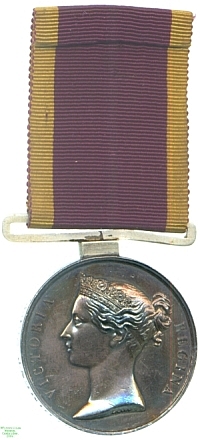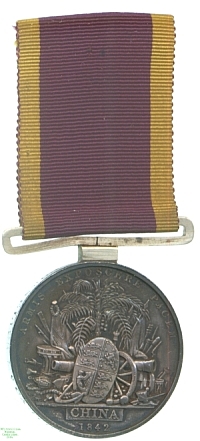
Obverse, a bust of Queen Victoria

Reverse, a collection of war trophies including a royal shield below palm tree

Obverse, a bust of Queen Victoria |

Reverse, a collection of war trophies including a royal shield below palm tree |
In the early nineteenth century British commercial interests in China were mainly focussed on the sale of opium imported from India. The import monopoly was fiercely defended by British resident merchants, but in the 1830s the Chinese government, conscious that the drug traffic was creating a serious social problem and also badly damaging the balance of trade, began to clamp down on it and to try to prevent importation at all. By 1839 this situation had broken out into violence, both official and popular; warehouses were burnt, British residents evacuated from Guangzhou (Canton) and many British properties burnt or pillaged. The Cantonese evacuation led directly to the British conquest of Hong Kong by the evacuated forces, after which Chinese forces began to engage the British at sea and all trade was prohibited.
British retaliation was not long in following, but the fragmentation of Chinese administration meant that a great many treaties secured very little gain for either side, until the British forces moved on Guangzhou in 1841, securing a shortlived peace. After this broke down, a series of further British successes up the Pearl River from Guangzhou culminated in the capture of Nanking and a treaty of `everlasting friendship' between the two countries in 1842. War would be renewed in 1857.
This medal was the second designed for this campaign; the first was withdrawn as offensive to the Chinese. It was issued to members of forces, both Army and Navy, involved in the 1840 capture of the island of Zhoushan (Chusan), or the subsequent campaigns of 1841 onwards up the Pearl River.
This medal was awarded to Private Cornelius McCarthy of the 49th Regiment. Lester Watson acquired it at some point before 1928.